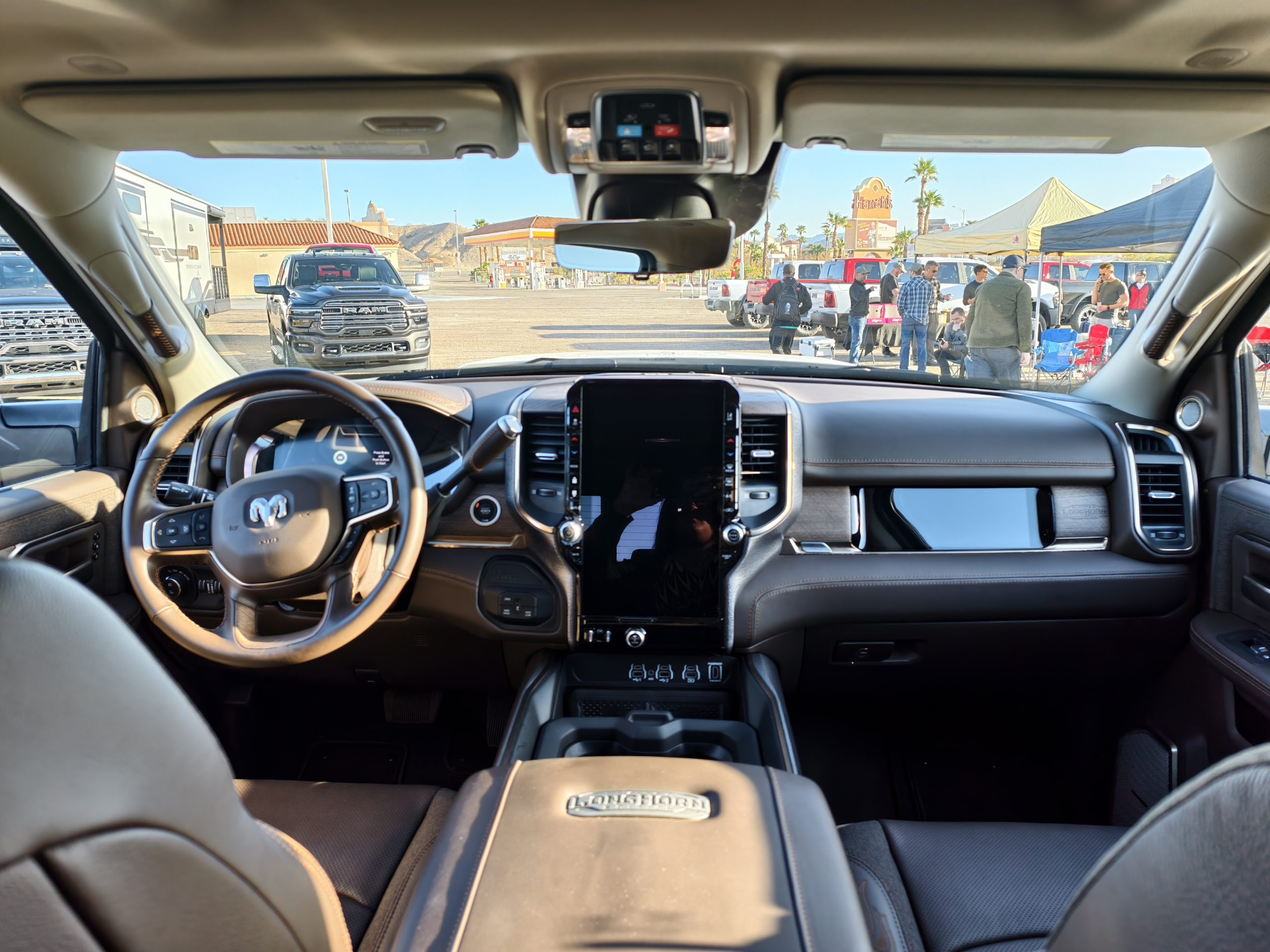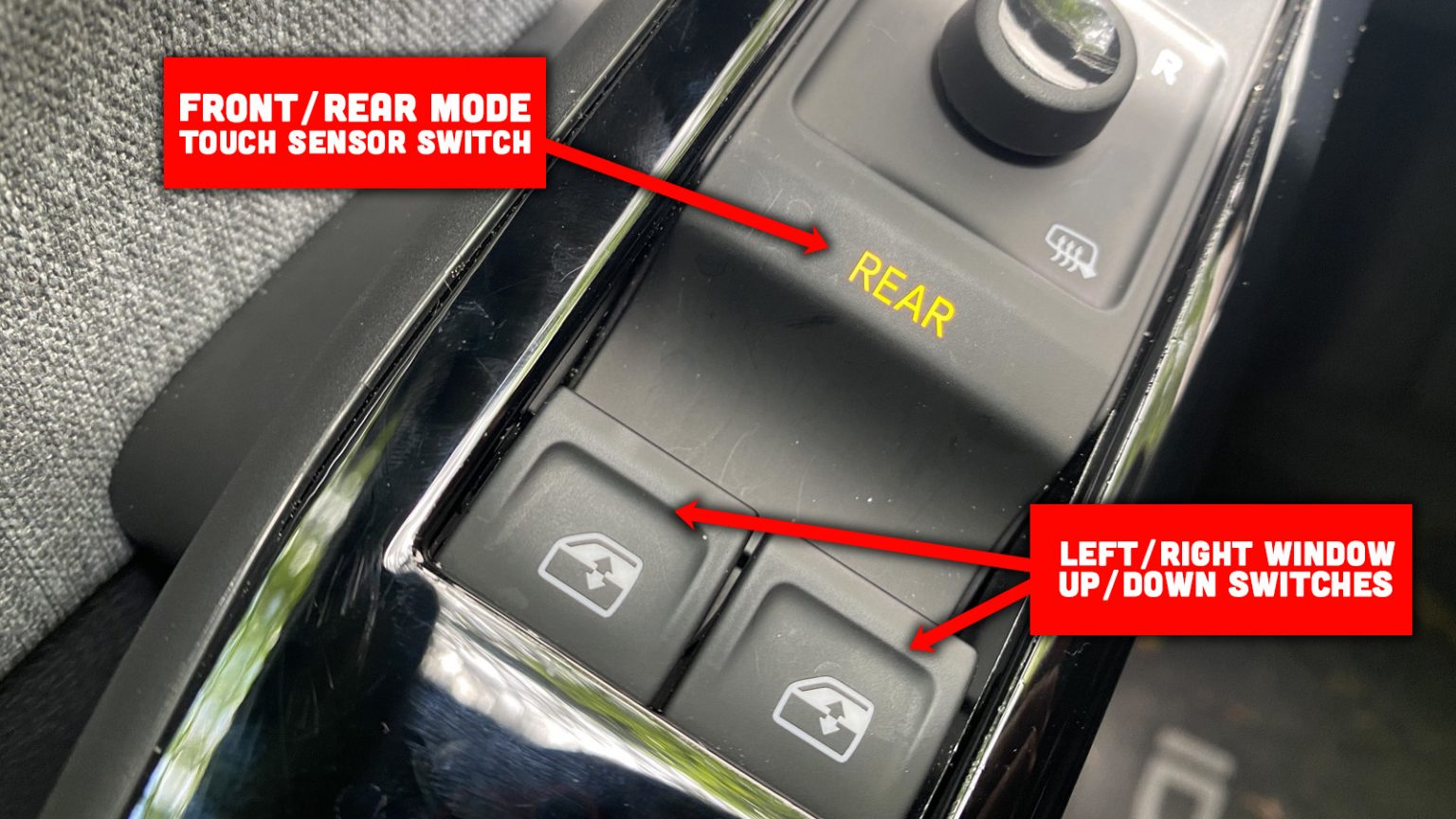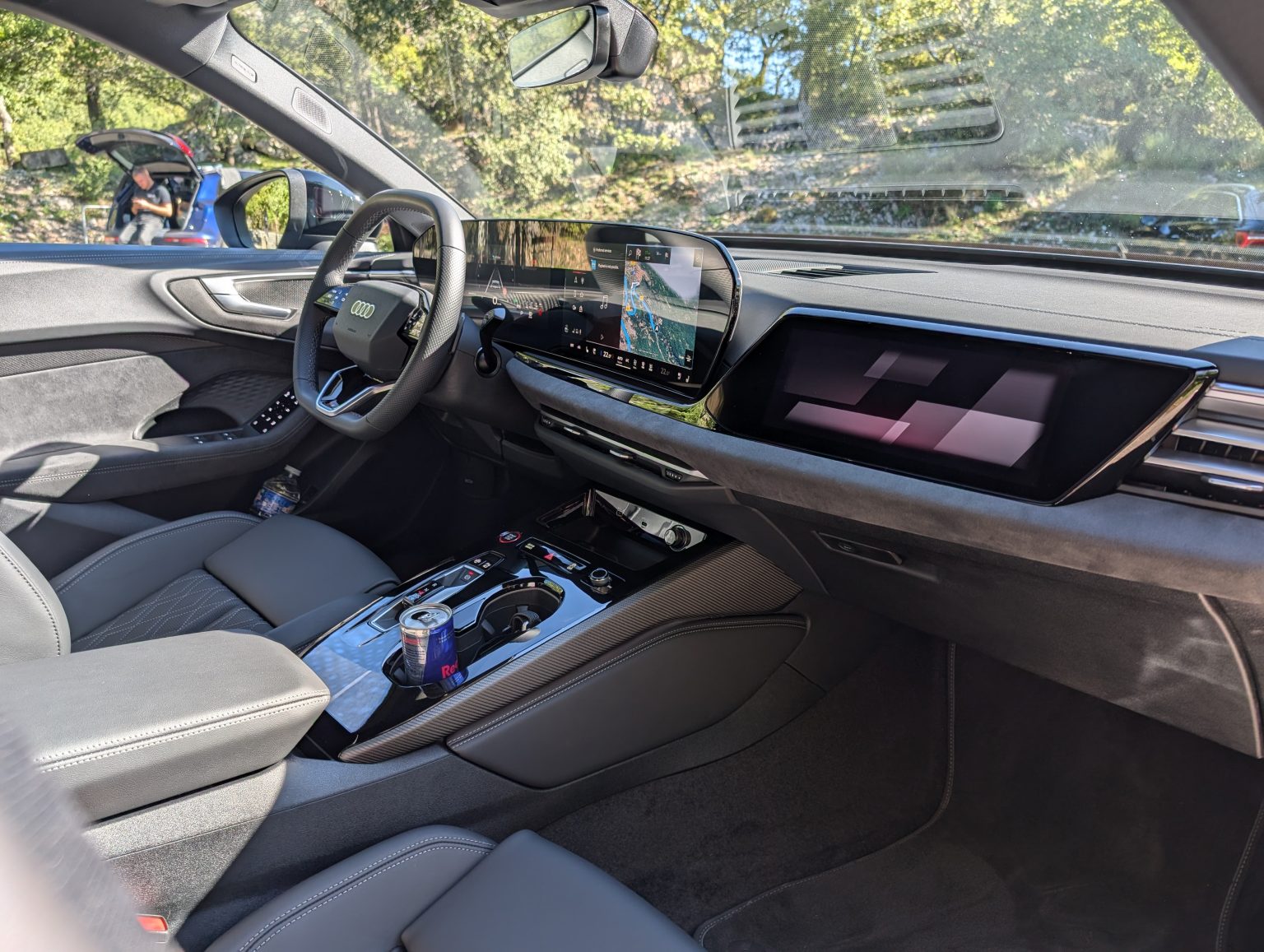Have you driven a new car lately and wondered exactly why in the world someone decided a certain piece of tech belonged in it? It turns out that you’re not the only one, and we’re beginning to see some of this tech slowly leave cars. This also applies to Ram, which is now realizing that passenger dashboard screens might have been a mistake.
Last week, I had a hectic period of about 24 hours when I hustled with a bunch of other journalists and YouTubers to drive all of Ram’s hot new Heavy Duty trucks. Out there in the warm desert, I learned that Ram absolutely hit these trucks out of the park. Ram’s newest heavy pickup trucks make towing so easy and so comfortable that your grandma can do it and feel confident.
These trucks are also packed with fresh technology, too. You can drive one of these things with a 19,500-pound tractor hooked to the bed while the radar cruise control still works just fine. These trucks will help you back a trailer, see past the super-high hood, and immerse you in heavy bass tracks while cooling your tush from your leather throne.

It’s incredible how far vehicle technology has come, but some of it has felt unnecessary. One of Ram’s tech features is the availability of a 10.25-inch infotainment display just for your front seat passenger. Your passenger can use this screen to watch a movie or play games through HDMI, set navigation, play music, or play around with the truck’s cameras.
That sounds pretty cool and all, but do you really need it? Automakers are finding out that the answer might be no.
No Buttons For You

Ram isn’t the only automaker jamming arguably too much technology in vehicles. Back in 2021, I had the privilege of being one of the first to test out the then-new Volkswagen ID.4 AWD. I’m one of the few people who actually love the ID.4 AWD, but there was something that really bothered me about it.
For several decades, cars have had really simple ways to manipulate the controls for their HVAC systems, audio systems, and other vehicle features. But now everyone seems to be obsessed with minimalism. Volkswagen began ditching buttons for touch capacitive sliders and options behind menus on its screens. The brand even fussed with its steering wheels, replacing perfectly functional buttons with more touch capacitive pieces. Admittedly, the touch stuff in itself wasn’t too bad, but then VW neglected to give these pieces backlighting. Nobody wants to turn on a cabin light just to adjust temperature, Volkswagen.

If you visit a Volkswagen forum, you’ll find some bickering about this. While some people don’t mind the capacitive buttons, others hate how they accidentally hit the touch capacitive steering wheel buttons while turning or how they have to physically look at a control to hit it with their finger because Volkswagen decided to put the headlight switch onto a button bank rather than a dial or stalk.
Keep in mind that Volkswagen has also tried eliminating rear window switches on the driver door. Instead, you have just two switches and once again another touch capacitive switch to turn on the rear windows.

I know I’m beating on Volkswagen a lot here, but this has been a thing across lots of automakers. Tesla is infamously allergic to buttons and putting basically everything behind a central screen. BMW and Hyundai also leaned heavily on deleting buttons and putting their functions behind screens. [Ed Note: And Tesla is pretty bad about this, too, with the Cybertruck turn signal switches being the worst of any mainstream car IMO. –DT].
Who Asked For This?
But then you just have even more arguably useless features. Late last year, I flew out to France to test the new Audi S5 and found that car to be laden with tech that I wonder how many people actually use. Some of the new tech was legitimately cool, like the headlights and taillights that were basically super bright displays. Then, the lack of buttons reared their ugly head again. The worst of all was the passenger screen. It has a similar list of functions like the passenger screen that you get in a Ram truck, but I often wondered who, exactly, was it for?


It was fun to play with for a few minutes, but then I took note that I was still holding my phone while I was fiddling with the passenger screen. What’s stopping me from just using my phone for entertainment as I have regularly since I bought an iPhone 4 back in 2012? It’s not like the screen does anything my phone doesn’t.
This doesn’t even get into how pointless native operating systems tend to be inside car infotainment systems. Most people will immediately turn on Android Auto or Apple CarPlay while fewer people like myself will still use old-school Bluetooth. Do you even know all of the different apps your car’s infotainment system has? The last time I used a Ford infotainment system, its keyboard defaulted to alphabetical order rather than qwerty. Sure, that’s minor, but minor annoyances add up! Now we have Stellantis products that glitched out with pop-ups and BMWs with subscription-based physical options.

My least favorite automotive development has to be always-illuminated dashboard (i.e. gauge cluster displays that require backlighting always). I’ve lost count of how many cars I’ve seen driving around with their lights off, but their drivers were probably blissfully unaware because their dashboards were lit up like a Christmas tree. Sure, there’s a little green indicator to tell you that your lights are on, but that’s clearly not enough. [Ed Note: Also DRLs have become really bright making it seem like headlights are on when they’re not. The result: Loads of cars driving around at night with no taillights!-DT].
I won’t even get into voice or gesture controls, but I think you get my point. There’s a lot of unnecessary technology in cars today and few drivers are happy about it. Reportedly, JD Power has noticed that your satisfaction with tech has gone down and so have automakers.
[Ed Note: I just want to jump in here and note that I recently drove an updated Rivian R1T and R1S, and their over-use of tech — like idiotic electric vents, electric center console lid latch, and electric door latches — actually made them feel dated. These once-charmingly gadgety features now just feel old to me. -DT]
Volkswagen Gives Back Buttons
A couple of weeks ago, Autocar released a bombshell of a report seeming to suggest that Volkswagen regrets taking your buttons away. Now, the company is running back to buttons. VW design chief Andreas Mindt said, via Autocar:
“We will never, ever make this mistake any more. On the steering wheel, we will have physical buttons. No guessing any more. There’s feedback, it’s real, and people love this. Honestly, it’s a car. It’s not a phone: it’s a car.”
Ram’s Passenger Screen Is Lacking Fans

During the Ram trip, I spoke with Doug Killian, Chief Vehicle Synthesis Engineer, during a nice press dinner. Our conversation was more casual. I love seeing what engineers do in their jobs and what gets them excited. Killian was refreshingly honest, admitting that not everything is a home run. In our conversation, he noted that Ram might have discovered that passenger screens are a piece of unnecessary technology.
Ram found out from its customers that few people actually use the passenger screen. As I noted before, everyone is carrying around a phone nowadays, so a dashboard screen for the passenger is quite redundant.

Ram found out that a passenger screen might not be as useful as putting screens in the backseat. Most of the time, the passengers in the rear of the vehicle will be kids who will want to use those screens for movies and games. However, the person sitting up front will likely be an adult who already has a phone.
Another journalist at the event noted another problem. Some adults, and this includes me, sometimes get carsick when trying to operate one of these passenger screens. In my case, there’s even a 50/50 chance I’ll get sick using my phone as a passenger in a car. So, if you’re an automaker like Ram, you have a set of people who have no need to use the screen because they have a phone and other people who won’t use the screen because they don’t want to barf.


Ram also found that some people would rather just have another place for storage rather than another screen. In Ram trucks without the passenger screen, that part of the dashboard opens up to become a handy place to store sunglasses, lip balm, sunscreen, and other daily items that you don’t want to shove into a glovebox. This legitimately useful space gets lost to become that screen that apparently a number of people don’t like.
Nothing is set in stone yet, but Killian says Ram might explore options on what to do about the screen. Perhaps we might not see the screen in future trucks or maybe customers will get an easy choice. Want a Longhorn but not the passenger screen it comes with? Maybe that’ll be an option in the future. For now, Ram is aware that the screen seemingly has few fans and that the screen might have been unnecessary. It seems like more research will be needed.
Either way, these recent events are signaling that automakers are becoming aware that there might be a thing as too much tech. It’s seriously awesome what the cars of today are capable of, but maybe cars should be cars and smartphones might be smartphones. Maybe we’ll begin to see more automakers realizing that sometimes simpler really is better. Sometimes, if it’s not broken maybe it really doesn’t need to be fixed.





Amen. I didn’t realize how aggressive VW was, I’ve recently had a Taos and Tiguan as rentals and they had plenty of physical controls. Maybe because they’re not the shiny new models? My biggest complaint is that the headlight switch is way down on the left of the dash closer to your knee, and as far as I could tell there was no icon on the dash to show you when the headlights were on. At least it was the peak of HVAC controls: 3 knobs and a couple extra buttons.
Is the Ram’s passenger screen a goddamn CRT? That cubby space is huge! A touchscreen should only make the door a bit thicker, not block the space entirely.
In my opinion, probably the worst part about that unnecessary screen is that it’s too small for how far away it is. It doesn’t look that much larger than a large smartphone screen so now the front passenger is looking at worse screen farther away than the one in their pocket. Especially in a society where even babies have smartphones and tablets within arm’s reach, it’s both surprising and not how this nonsense got greenlit.
The lack of physical switch gear has/is a cost-cutting move and mostly nothing else. I see it as praying on stupid shallow consumers who’s first inclination is to think anything with a touch based interface is leading edge technology and must be better than a physical button…so “I gotta have it!!”. My first thought is that whatever engineering/design/mfg costs that go into things like passenger screens, could be, once they start decreasing investments in those screens, put back into more physical buttons. Obviously that’s assuming that the manufacturers would be willing to “give back” those cost gains that they obtained by getting rid of physical switchgear once upon a time. Fat chance, I know.
I own a ’23 Tiguan and I’m glad VW went back to physical buttons on the steering wheel that year. What still sucks is that the HVAC system uses capacitive touch buttons that require taking my eyes off the road to use. It’s the one bad feature in a car I’m otherwise very happy with.